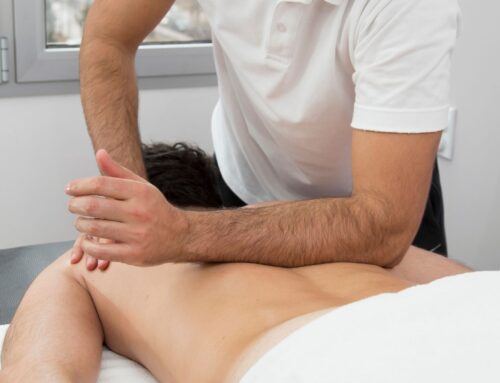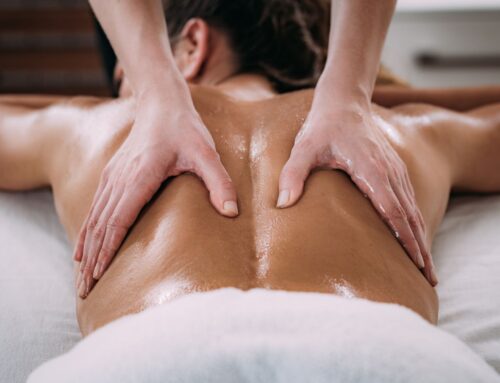Deep tissue massage (DTM) is a particular form of massage therapy used to treat many issues, including high blood pressure, low back pain, and reduced range of motion. This form of massage therapy consists of many different techniques that can be used to address specific areas of concern and promote overall wellness.
In this blog article, we will outline the different techniques used by registered massage therapists, which conditions it can be effective in addressing, as well as the physical benefits associated with deep tissue massage.
Table of Contents:
What is Deep Tissue Massage
Deep tissue massage is a specialized massage technique that targets the deeper layers of muscles and connective tissues. Unlike traditional Swedish massage, which primarily focuses on relaxation, deep tissue massage is a massage technique that focuses on the deep tissues including the muscle, fascia, and connective tissue.[i]
DTM is most often performed on areas prone to pain such as the shoulder, neck and waist. Overall, this therapeutic approach aims to break down adhesions, release tension, improve blood circulation, and restore optimal functioning of the musculoskeletal system.
You may also enjoy reading: The Benefits of Myofascial Release Massage
Deep Tissue Massage Techniques
Deep tissue massage therapists employ various techniques to address specific areas of tension and discomfort. Some common techniques include:
- Slow strokes with the aim of stretching the muscle’s fibres.
- Maintaining depth of treatment to target deep tissues
- Using body weight to generate the force transmitted through the hands, knuckles or elbows to use gravity which reduces muscle fatigue for the registered massage therapist.
- Stretching or activation of muscle to establish connection between the brain (which initiates movements) and the muscle.
The application should be within the client’s parameters of comfort (minimally painful or no pain at all) as deeper muscle layers may be more sensitive than surface layers.[i]
You may also enjoy reading: The Benefits of Swedish Massage
Benefits of Deep Tissue Massage
Numerous scientific studies have explored the many physical benefits that deep tissue massage offers. Here are some of the key advantages:
1. Reducing Blood Pressure
In a large study with 263 participants, it was found that deep tissue massage caused a large decrease in blood pressure. This included both systolic pressure (the pressure in the arteries when the heart beats) and diastolic pressure (the pressure in the arteries when the heart rests between beats).
Mean arterial pressure (MAP), which is average blood pressure in an individual during a single cardiac cycle and heart rate (HR), measured in beats per minute, also decreased following DTM.[ii]
You may also enjoy reading: Myofascial Trigger Points and Back Pain
2. Improving Range of Motion (ROM)
Another study investigated a group of subjects with neck pain. Those that were treated with 10 sessions of Rolfing, a form of deep tissue massage, experienced an increase in their active range of motion (AROM).[iii]
For instance, they were able to rotate their neck 13 degrees more on average in both the left and right directions. In fact, subjects’ range of motion increased in all categories including left and right rotation, left and right flexion, extension, and flexion in general. Average pain levels also decreased significantly for all subjects.[iii]
You may also enjoy reading: Thai Massage Services
3. Decreasing Pain
- Cesarian – Cesarian sections can cause numerous challenges for mothers, most notably pain. This pain can then lead to anxiety and feeling uncomfortable. One particular study examined how deep tissue massage could be used to combat this. Compared to those that did not receive deep tissue massage, those that did reported higher comfort levels and lower scores on a pain scale.[i]
- Decreased Low Back Pain – Non-specific back pain is back pain that is not caused by any known condition. Researchers set out to find whether deep tissue massage could increase pain threshold and lower pain levels. They did in fact report an increase in pain threshold as well as a decrease in the VAS scale similar to what was found in the caesarian section study.[iv]
- Decreased Plantar Heel Pain – Plantar heel pain syndrome is common and occurs at a rate of 10% in the general population. Researchers determined that deep tissue massage is also an effective treatment for plantar heel pain. They performed deep tissue massage on the calves of subjects with this form of pain and concluded that it is effective at reducing pain. Pain tolerance was also increased in subjects that applied heavy rolling and manual massage on the plantar flexor muscles found in the calf.[v]
Conclusion
Deep tissue massage offers a therapeutic approach to alleviate tension, restore balance, and enhance overall well-being. By targeting the deeper layers of muscles and connective tissues, this technique provides numerous benefits ranging from pain relief and increased mobility to improve athletic performance.
At Propel Physiotherapy our registered massage therapists are trained and experienced in various treatment techniques. Feel free to contact us and book a complimentary consultation with one of our registered massage therapists to learn how you can incorporate DTM into your therapy regimen to help decrease your pain and improve your mobility.
References
[i] Güney, E., & Uçar, T. (2021). Effects of deep tissue massage on pain and comfort after cesarean: A randomized controlled trial. Complementary Therapies in Clinical Practice, 43, 101320. https://doi.org/10.1016/j.ctcp.2021.101320
[ii] Yeun YR. Effectiveness of massage therapy on the range of motion of the shoulder: a systematic review and meta-analysis. J Phys Ther Sci. 2017 Feb;29(2):365-369. doi: 10.1589/jpts.29.365. Epub 2017 Feb 24. PMID: 28265175; PMCID: PMC5333006.
[iii] Forman, J., Geertsen, L., & Rogers, M. E. (2014). Effect of deep stripping massage alone or with eccentric resistance on hamstring length and strength. Journal of Bodywork and Movement Therapies, 18(1), 139–144. https://doi.org/10.1016/j.jbmt.2013.04.005
[iv] Zheng, Z., Wang, J., Gao, Q., Hou, J., Ma, L., Jiang, C., & Chen, G. (2012). Therapeutic evaluation of lumbar tender point deep massage for chronic non-specific low back pain. Journal of Traditional Chinese Medicine, 32(4), 534–537. https://doi.org/10.1016/s0254-6272(13)60066-7
[v] Saban, B., Deutscher, D., & Ziv, T. (2014). Deep massage to posterior calf muscles in combination with neural mobilization exercises as a treatment for heel pain: A pilot randomized clinical trial. Manual Therapy, 19(2), 102–108. https://doi.org/10.1016/j.math.2013.08.001
Written by
















